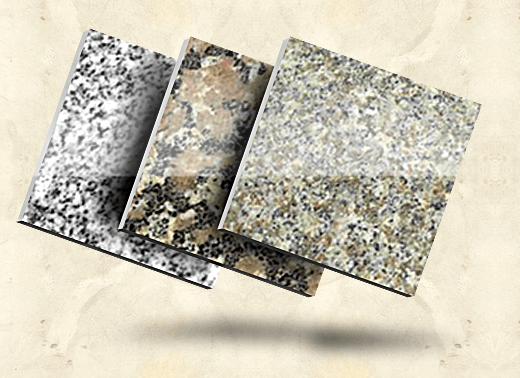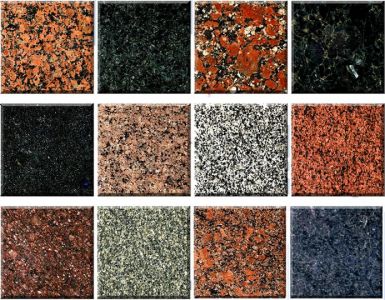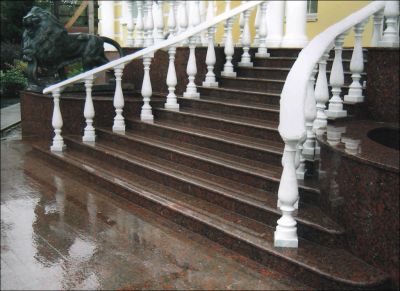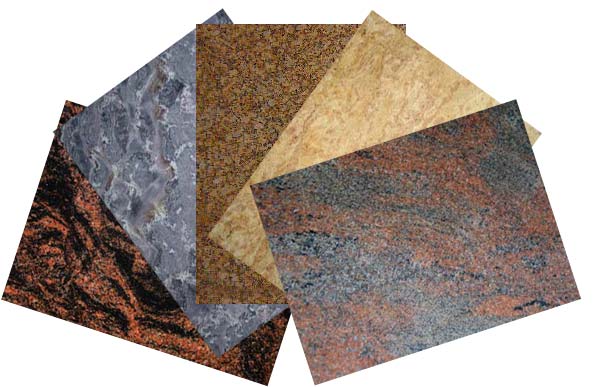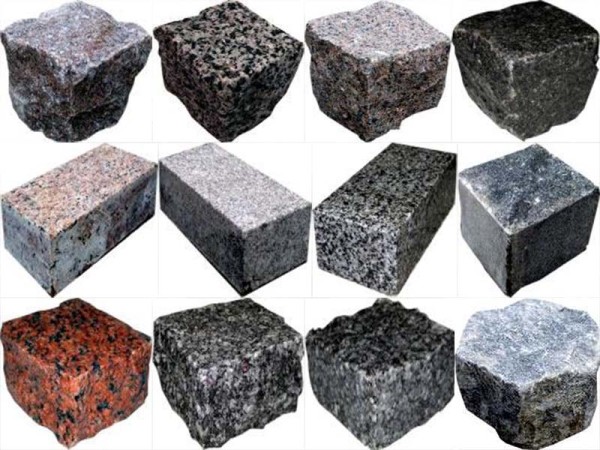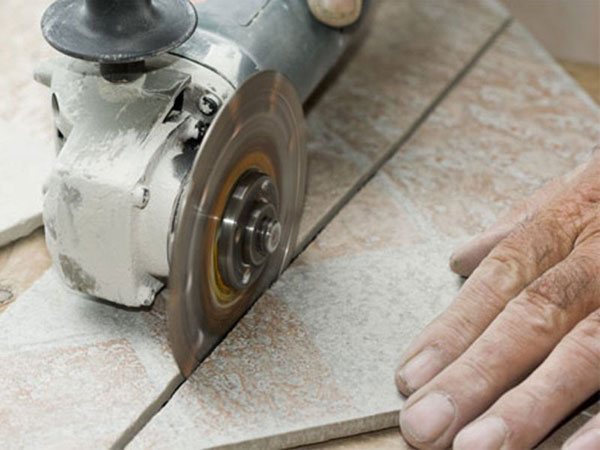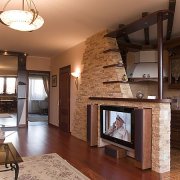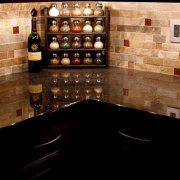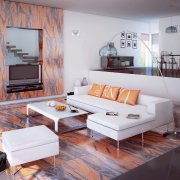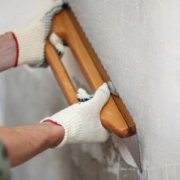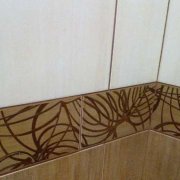Facing with granite slabs: application and characteristics
Facing with granite slabs is quite popular recently. It helps to create the original design of any room.
The content of the article
Where can I use granite slabs in the decoration
Granite facing slabs can be used both in interior and exterior decoration.
In the interior:
- On the surface of walls and floors.
- For fireplace trim.
- For kitchen worktops and coffee tables.
- Creation of decorative panels and much more.
In the exterior:
- On the basement.
- On the walls of houses.
- At the corners of the building.
- For finishing the fence and stuff.
Tip. To use granite slabs for cladding, you must first specify in which region the granite was mined and whether it has radioactive emissions.
Types of Granite Tiles
Granite facing tile can be varied.
There is:
- Novodanilovsky granite.
- Kapustinsky granite.
- Tokovsky granite.
- Mezhirichsky.
- Pokostovsky.
- Vasilievsky.
- Labradorite.
- Korninsky granite.
Note. They are similar in their constituent parts (feldspar), only in the external design they have significant differences. The photo shows examples of such rocks of natural agglomerate.
Characteristics and features of each type
Granite cladding tiles are made by sawing a large layer of granite. The thickness and size of the finished tile may have various sizes.
Novodanilovsky granite, and slabs from it:
- This type of material has a rather interesting design and is particularly durable.
- On its surface, you can see spots of a small red size.
- On top of them is a gray tint that tones the brightness of the color.
- In most cases, it is used for cladding countertops.
Kapustinsky granite
- Lining with granite tiles made of Kapustinsky granite has the same red spots, similar to flowers.
- They are also muted in gray, but in a darker shade than in Novodanilovsky granite.
Tokovsky granite
- This type of granite slabs has a very attractive brown hue, which comes without any specks of other colors.
- Tokovsky granite is very practical, because its surface due to the uniformity and dark shade is non-marking, which makes it possible to use it in exterior cladding works.
Mezhirichsky granite
- Facing granite tiles made of such a material have very warm colors. These are mainly beige tones.
- It is not worth using it for outdoor work, as dirt can be visible on a light surface.
- Most often, such granite is used in the decoration of fireplace portals.
Pokostovky granite
- The facing slab made of Pokostovsky granite has a very pleasant gray tint and is mainly used for floor finishes or outdoor work.
- Most often, the surface is glossy. Thus, the material gives sophistication and elegance to the finish.
Vasilievsky granite
- This type of granite differs from previous types in its bright surface design. It is smooth and has a green tint.
- The very structure of Vasilievsky granite is honey-grained, for this reason its surface is not smooth.
Labradorite
- It is considered the most practical type of granite. It has a very dark shade, which is close to black.
- There are also bluish overflows. The surface is smooth and glossy. It is used both in exterior and interior decoration.
Tip. Its surface is very afraid of alkaline environment and because of this it is necessary to clean it only with a damp rag.
Korninsky granite
- Lining with granite tiles from Korninsky has become very popular lately.
- This is due to the fact that granite of this breed has pink and dark gray colors in its design, and this combination is currently the latest fashion trend in interior design.
Granite tile surface types
Facing granite plates can have such surfaces:
- Polished.
- Polished.
- Pounding.
- Polished.
- Rough
- Sawn.
Features and specifications:
- The polished surface of the granite tile has not a pronounced roughness, but a very saturated shade.
- Polished is distinguished by its exquisite brilliance. It has a gloss and is suitable for outdoor facade cladding and for interior work on a vertical surface.
Tip. This type of granite tile surface is not recommended for use in flooring, as the material is very slippery.
- The chipped surface is the result of a very rough process of processing the material. It has a relief and in its appearance is very similar to the natural design of granite.
- The polished surface has a roughness. Quite often used for finishing work on the floor. It has an attractive appearance and does not slip.
- The rough surface is characterized by a pronounced structure of natural agglomerate. In this case, granite is cut using a special laser.
- The sawn surface is also characterized by roughness, but not very pronounced. After processing, traces of the use of special equipment may remain on it.
In order to cut granite in this case, cables or circular saws are used.
Tip. The glossy surface of granite tiles is best used for indoor or outdoor use, but only on vertical surfaces.
Properties and advantages of granite tiles
Granite facing tiles are a universal finishing material. For him, there are no restrictions on how to design a particular surface.
The main properties and characteristics of such a material will be:
- Strength. Granite tiles are so strong that they can withstand loads of more than 100 kg per 1 sq.m.
- Wear resistance. The surface of the tile does not wear out and does not deteriorate over time, even if it lies on the floor in a place with high traffic.
- Moisture resistance. Tiles do not absorb moisture. After wet cleaning, its surface may darken, but this is only for a certain time.
- Practicality. Dirt and dust are not absorbed by granite. For this reason, cleaning the finish becomes very quick and easy.
- Impact resistance. Tile even after falling. It does not crack or crack.
- Durability. The term of use of granite tiles in the cladding is unlimited.
- Fire resistance. Due to its structure, natural stone is not exposed to a direct source of fire and is not deformed by high temperature.
- Frost resistance. This quality of the material makes it possible to use it without problems in exterior finishing work not only on the building, but also on walkways, arbors and other decorative elements.
Note. In addition to the advantages of granite tiles, there is one significant drawback, the price of the material is quite high, due to the environmental friendliness and naturalness of the material.
Surface Mounting of Granite Tiles
Granite tile, despite its heavy weight, is mounted quite simply and quickly. To do this, you will not need to have certain skills in this area and without much effort to do all the actions yourself.
Initially, it is worth determining which surface will be installed on:
- On a vertical surface.
- On the horizontal.
A number of preparatory work will depend on this:
Tip. To install granite tiles on the surface of the floor, it is worth considering that the material is cold and you must initially insulate the surface.
- For this, expanded clay is used, from which filling is made on the floor and after that the floor is poured with a concrete screed.
As for the walls, it will be enough that they are even.
If the work with granite tiles is performed on the facade of the building, then warming is also performed using:
- Styrofoam.
- Mineral wool.
- Styrofoam and other solid insulation, which also serve as insulators.
Tip. Plasterboard or OSB sheets with obligatory finishing with plaster or concrete mortar should be mounted on top of them to ensure a normal bond with the adhesive solution for fixing the plates.
Tools and improvised tools that will be needed in order to fix the cladding with granite plates:
- Building level. According to his testimony, every element of granite finish is exposed.
- Cross-shaped beacons in the case of mounting tiles at a certain distance from each other.
- Adhesive or concrete mortar.
- Capacity for mixing such solutions.
- Construction mixer to give uniformity to the mass and reduce the time for the preparation of solutions.
- Drill or hammer drill.
- Nails, dowel screws (in the case of mounting tiles on a brick or other stone surface).
- Decorative putty. After installing the granite tiles, each lining joint seam is processed.
Tip. In order to prepare a cement mortar there is a certain instruction. According to it, 1 bucket of cement goes to 3 buckets of sand. Water is added depending on the required consistency of the composition.
Performance of work:
- If granite tiles have a large mass, then it is worthwhile to strengthen the surface with the help of a reinforcing mesh that is attached to the surface and layers of cement mortar or plaster (starting) are superimposed on it.
- What is better to choose for the installation of granite tiles: concrete mortar or special glue? If the mass of the tile is quite large, it is better to use a concrete mortar. In other cases, special glue for natural stone is most often used.
Tip. For the installation of reinforcing mesh on the surface, it is not recommended to use finishing plaster, which does not have the strength as a starting plaster, but serves only to hide defects.
The video shows the process of installing granite tiles on the surface.
